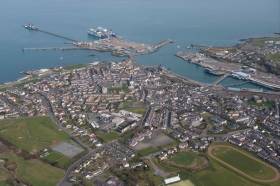Displaying items by tag: World largest Ro Ro ferry
World's Largest Ro-Ro Freight Ferry Completes Maiden Voyage from Continental Europe to Dublin Port
#WorldLargest - An historic milestone in Dublin Port took place late last night as Celine, the world’s largest short-sea ro-ro freight ferry completed a commercial maiden voyage from mainland continental Europe, writes Jehan Ashmore.
On arrival from Zeebrugge, Belgium, a pair of tugs assisted the giant Celine to dock in Dublin Port just after 23.00hrs.
At 234m long the sheer length of the new ship was demonstrated in that Alexandra Basin East’s Ocean Pier is 242m. The measurement of the ship does not take into account the length of the ship's stern loading ramps when lowered into position at the berth's linkspan which itself is part of the overall pier length. As such Celine's bow has extended beyond the pier out into the port’s main internal shipping channel, unlike fleetmate Valentine of just 162m (see photo related story).
At 74,000 gross tonnage, Celine is easily the biggest capacity ro-ro freight ferry to Dublin Port having sailed on the Rotterdam-Zeebrugge to the Irish capital with up to 8,000 freight lane meters. The next largest regular ro-ro ship using Dublin is Irish Ferries cruiseferry giant Ulysses of 50,000 gross tonnage and around half the freight unit capacity.
Ships such as Celine serving direct Ireland-continent services have raised concerns with landbridge routes via the UK, notably Holyhead, see story posted on Afloat yesterday.
Celine can handle 600 freight units which will provide Irish exporters with additional capacity and greater flexibility by trading with markets in continental Europe, particularly in post-Brexit. The range of cargoes includes unaccompanied trailers, tank containers, project cargo, new cars and a capacity for 12 driver accompanied units. The ro-ro ship however will also include a North Sea link from Belgium to the UK.
Landlocked based operators, CLdN Ro Ro S.A. of Luxembourg had placed the order for Celine to South Korean yard of Hyundai Heavy Industries at their Mipo Dockyard in Ulsan. Celine also has green credentials in that the newbuild is 'LPG ready' which brings greater flexibility to operations.
The debut of Celine also marks a significant era for CLdN /Cobelfret Ferries as the newbuild is the first of a major intensive fleet expansion programme with a sister due for delivery later this year. The programme is for 12 newbuilds, so far six have been completed. They will join an extensive short-sea network across northern Europe.
Asides the ports mentioned that Celine is serving, other members of the 24 strong ro-ro fleet also operate other routes calling to Gothenburg, Esbjerg, Hirtshals, Santander and Porto.
#GiantFerries - The world’s largest ferry which is to arrive on a Dublin to continental Europe route writes The Daily Post has sparked post Brexit fears over trade at Holyhead port.
The 234m ro-ro freight ferry Celine as reported on Afloat.ie is being introduced on an Ireland to Belgium/Dutch route by cargo group CLdN - increasing capacity on that service.
There are concerns this is part of a wider trend to hike up capacity on routes to and from Ireland that by-pass the UK to avoid potential tariffs and customs delays after Brexit.
A new ferry is to introduced between Holyhead and Dublin next summer. Afloat adds this is Irish Ferries giant cruiseferry WB Yeats which as the biggest ferry on the Irish Sea will considerably boost capacity notably also on another continetal route to Europe that been between Dublin and Cherbourg.
Port bosses at Cork have already said they expect to see a “reorientation of logistics” post.
This would be bad news for Holyhead - the second largest ferry port in the UK after Dover - with the risk that trade is lost to these routes.
Anglesey MP Albert Owen said he has been raising this issue for months but fears the message is not getting through.
For much more on the ferry sector including political comments from both sides of the Irish Sea, click here.






























































